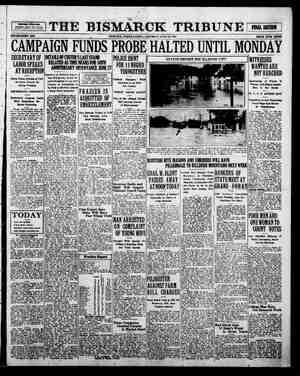The Daily Worker Newspaper, June 19, 1926, Page 7
You have reached the hourly page view limit. Unlock higher limit to our entire archive!
Subscribers enjoy higher page view limit, downloads, and exclusive features.
ALEX. BITTELMAN, (Bumplmet c+ THE DAILY WORKER. Editor Second Section: This Magazine Section Appears Every Saturday in The DAILY WORKER. Why a Labor Party? EMOCIRATIC 91 DATE By Fred Ellis | eo Look at Minnesota nois, Pennsylvania, lowa and a few other places, it will be in-| themselves. In Pennsylvania things have turned out*just as bad and for similar reasons. The official labor leaders in Pennsylvania, despite the existence. there of a Labor Party which should nominate its own candidates, entered into the republican primaries to support the “best” man. They hit upon Pinchot for senator and Beidelman for governor. How much these two are better than either Pepper, or Vare or Fisher or any of the other capitalist. candidates in the republican race, we have never beep able to find out. But what was the result? That neither Pinchot nor Biedelman received the nom- ination. These went to Vare and Fisher—two politicians that are na good even according to the reactionary labor leaders in Penn- sylvania. Yr a In Iowa things seem to be a little better than in Illinois or Pennsylvania, The candidate who received the republican nomina- : for senator in lowa—Smith W. Brookhart—is politically really structive to have a look at Minnesota. There is something very special and characteristic about the coming primaries in Minne- sota worth while following, studying and—to an extent—imitating. The Minnesota Farmer-Labor Party. "AETER everything that happened in the primary elections in Illi-| primaries? Nothing. They have helped their enemies against HERE is ‘a Farmer-Labor Party in Minnesota, an active political organization which has considerable standing among the. work- ers and farmers of the state. It is 8 years old. This party placed its first ticket in the field against the tickets of the republican and democratic parties in the general elections of 1912, when the farmer- labor candidate for governor received 31.5 per cent of the vote. At the general elections of 1920 the farmer-labor nominee for the same office polled 36 per cent of the vote; in 1922, 48 per cent, and in 1924, 44.5 per cent of the vote, sae Tn the coming elections of 1926, the Farmer-Labor association of Minnesota will again challenge the two old parties and will un- doubtedly be successful in the effort, There, in the state of Minne- sota, the workers and farmers have proven satisfactorily that inde- pendent political action by the workers in alliance with the farmers not only is possible but also practical and advantageous to- the different from Senator Cummins who was defeated. At least the campaign that Brookhart conducted could be interpreted as hostile to Wall Street and friendly in a measure to the farmers and work- ers, But Brookhart is the candidate of the republican party, the party of Big,Capital, This party, if it at all permits the election of toiling masses, Brookhart to the senate, will either make him take its dictates or Not as Helpless as in Other States, reduce his effectiveness in the senate to nothing, The burning ques- Wit the adyent of the farmer-labor party in Minnesota, political tion, therefore, is this; is there going to be a party of workers in action for the workers and ‘farmers ceased to be the empty, fu-| alliance with the poor farmers to SUPPORT, DIRECT AND CON- tile and hopeless proposition that it still is for the workers and| TROL THE ACTIVITIES OF THEIR REPRESENTATIVES farmers in other places in the United States, And why? Because}CONGRESS? This question ia as relevant to Iowa as it jig to in most of the other states and localities the masses are still sup-} nois, Pennsylvania, ete., with the possible exception of Minn porting the old capitalist parties, ; where the situation is considerably different, It is different because A few recent political events will illustrate the point, During} there they have a Farmer-Labor Party, the last four weeks, we had primary elections ih about half a dozen This farmer-labor party in Minnesota, despite its serious short- _ states. What role did the workers and farmers play in these elec-| comings in program, organization and leadership, is nevertheless a tions? party of the toiling masses, It ig distinctly different from the old In Illinois they participated in considerable numbers in the} capitalist parties and is opposed to them, It is built on the right \primaries of the republican and democratic parties, That is, large idea—independent politica® action by the workers in alliance with masses of workers and farmers in Illinois have continued to recog-| the poor farmers—even though this idea is not very clear in the nize the old capitalist parties as their own, And what is the result} minds of many of its present leaders, cme a thus far? Smith is the senatorial candidate of the republicans, It is the presence in the field of this farmer-labor party » Brennan is the senatorial standard bearer of the democrats. Both!makes all the difference between the primaries in Illinois, P fe are old type capitalist politicians.. Both are opposed to the workers | sylvania or Iowa and those that are coming up in Minnesota. Here and farmers. Both are servile tools in the hands of various groups! the workers and farmers have a political organization which can of capitalists. be made to function in their own interests, Here they have an in. 7 ae What have the workers and farmers of Illinois achieved in these (Continued on newt page—page 2)




